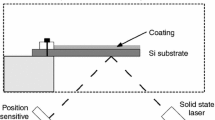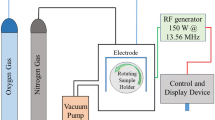Abstract
Despite its industrial importance, the subject of freeze-thaw (F/T) stability of latex coatings has not been studied extensively. There is also a lack of fundamental understanding about the process and the mechanisms through which a coating becomes destabilized. High pressure (2100 bar) freezing fixes the state of water-suspended particles of polymer binder and inorganic pigments without the growth of ice crystals during freezing that produce artifacts in direct imaging scanning electron microscopy (SEM) of fracture surfaces of frozen coatings. We show that by incorporating copolymerizable functional monomers, it is possible to achieve F/T stability in polymer latexes and in low-VOC paints, as judged by the microstructures revealed by the cryogenic SEM technique. Particle coalescence as well as pigment segregation in F/T unstable systems are visualized. In order to achieve F/T stability in paints, latex particles must not flocculate and should provide protection to inorganic pigment and extender particles. Because of the unique capabilities of the cryogenic SEM, we are able to separate the effects of freezing and thawing, and study the influence of the rate of freezing and thawing on F/T stability. Destabilization can be caused by either freezing or thawing. A slow freezing process is more detrimental to F/T stability than a fast freezing process; the latter actually preserves suspension stability during freezing.
Similar content being viewed by others
References
Bosen, S.F., Bowles, W.A., Ford, E.A., and Perlson, B.D., “Antifreezes,” Ullmann’s Encyclopedia of Industrial Chemistry, 5th Ed., Vol. A 3, VCH Verlag, 1985.
Blackley, D.C., Polymer Latices-Science and Technology, 2nd Ed., Vol. 1, Chapman & Hall, 1997.
Digioia, F.A. and Nelson, R.E., “Freeze-Thaw Studies of Latex Paint Polymers,” Ind. Eng. Chem., 745–748 (April 1953).
Bard, W.G. and Mikucki, W., “On the Coagulation of Polymer Latices by Freezing and Thawing,” J. Polym. Sci., 37, 499–514 (1956).
King, A.P. and Naidus, H., “The Relationship Between Emulsion Freeze-Thaw Stability and Polymer Glass Transition Temperature,” J. Polym. Sci., Part C, 27, 311–319 (1969).
Naidus, H. and Hanzes, R., in “Addition and Condensation Polymerization Processs,” Platzer, N.A.J. (Ed.), ACS Advances in Chemistry Series No. 91, American Chemical Society, Washington, D.C., Paper No. 11 (1969).
Blackley, D.C. and Teoh, S.C., Preprints of the International Polymer Latex Conference, Plastics and Rubber Institute, London, Paper No. 9 (1978).
Cockbain, E.G., Gregory, J., Pillai, N.M., and Gorton, A.D.T., J. Rubber Research Institute of Malaya, 22, 408 (1969).
Nakamura, A. and Okada, R., “The Coagulation of Particles in Suspension by Freezing-Thawing I. Effect of Freeze-Thawing Conditions and Other Factors on Coagualtion,” Colloid Polym. Sci., 254, p. 718 (1976).
Nakamura, A. and Okada, R., “The Coagulation of Particles in Suspension by Freezing-Thawing II. Mechanism of Coagulation,” Colloid Polym. Sci., 254, p. 497 (1976).
Ottewill, R.H. and Satgurunathan, R., “Nonionic Latices in Aqueous Media,” Colloid Polym. Sci., 273, 379–386 (1995).
Farwaha, R., Phan, L., and Currie, W., U.S. Patents 5,530,056 (1996) and 5,610,225 (1997), and EP 0 609 756 A3 (1994).
Okubo, M. Sakaguchi, S. Takamatsu, A., Sasaki, H., and Tsuneta, K., U.S. Patent 6,410,655 B2 (2002).
Zhao, C.L., Cunningham, T.A., and Zhuo, L., U.S. Patent 6,933,415 (2005).
Kostansek, E.C., “Using Dispersion/Flocculation Phase Diagrams to Visualize Interactions of Associative Polymers, Latexes, and Surfactants,” J. Coat. Technol., 75, No. 940, 27 (2003).
Diebold, M.P., Better, C.R., and Mukoda, D.M., “Mechanism of TiO2/ZnO Instability in Latex Paints,” J. Coat. Technol., 75, No. 942, 29–36 (2003).
Huang, Z., Thiagarajan, V.S., Lyngberg, O.K., Scriven, L.E., and Flickinger, M.C., “Microstructure Evolution in Polymer Latex Coatings for Whole-Cell Biocatalyst Application,” J. Colloid Interface Sci., 215, 226 (1999).
Sutanto, E., Ma, Y., Dittrich, U., Zhao, C.L., Zhuo, L., Davis, H.T., and Scriven, L.E., “Cryogenic Scanning Electron Microscopy of Early Stages of Film Formation in Drying Latex Coatings,” Proc. 10th International Coatings Science and Technology Symposium, Scottsdale, AZ, pp. 63–66, 2000.
Cansell, F., Grabielle-Madelmont, C., and Ollivon, M., “Characterization of the Aqueous Phase and the Water-Polymer Interface in Latex Suspensions by DSC,” J. Colloid Interface Sci., Vol. 144(1), 1–17 (1991).
Author information
Authors and Affiliations
Rights and permissions
About this article
Cite this article
Zhao, CL., Porzio, S., Smith, A. et al. Direct observation of freeze-thaw instability of latex coatings via high pressure freezing and cryogenic SEM. J Coat. Technol. Res. 3, 109–115 (2006). https://doi.org/10.1007/s11998-006-0013-6
Issue Date:
DOI: https://doi.org/10.1007/s11998-006-0013-6




